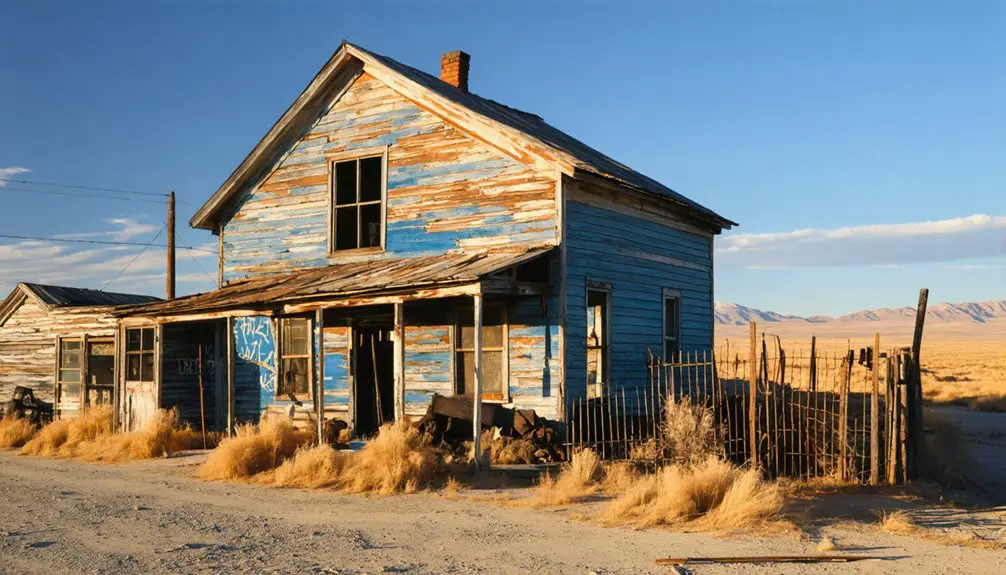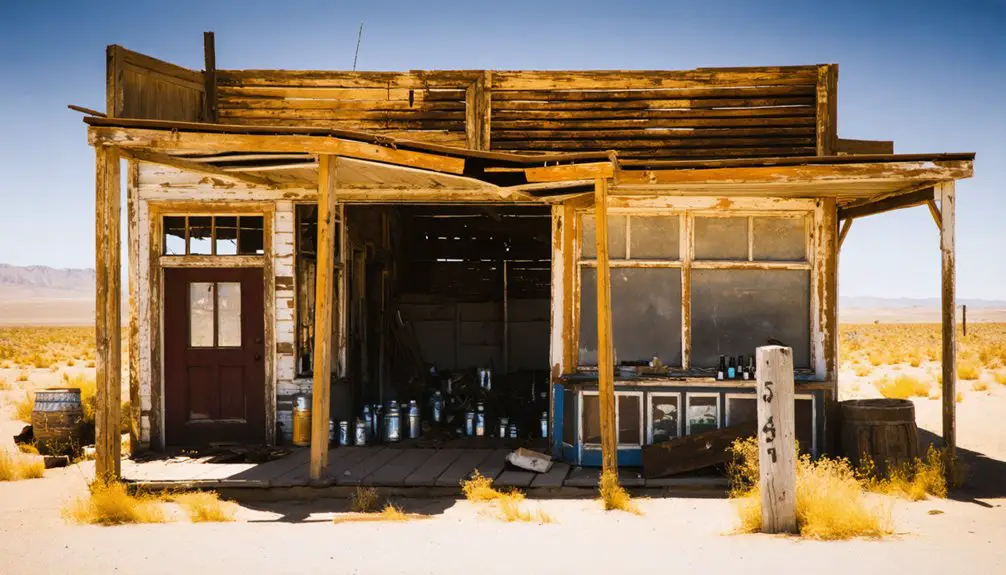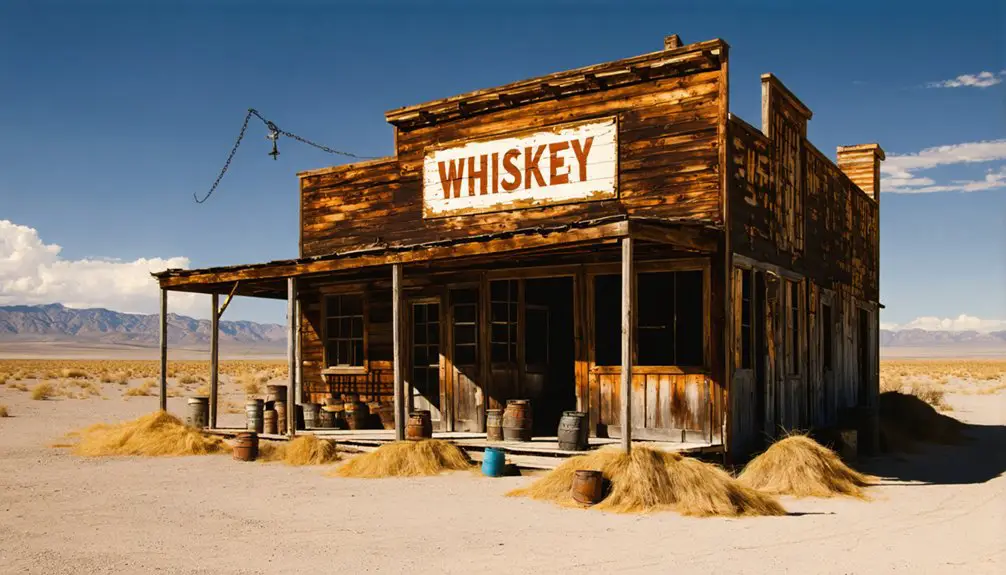You’ll find Lahontan City’s ghostly remains near Fallon, Nevada, where a single brick chimney stands as a sentinel to what was once a thriving federal company town built in 1911 for the construction of the Lahontan Dam. The site featured worker housing, a medical clinic, dining hall, and recreational facilities, serving hundreds of laborers including Eastern European immigrants who lived in nearby Bohunkville. While nature has reclaimed most structures, the site’s rich history of innovation and community life awaits your discovery.
Key Takeaways
- Lahontan City was a federal company town established in 1911 to house workers building the Lahontan Dam in Nevada.
- The town featured framed houses, a dining hall serving 300 people, medical facilities, and recreational amenities for its diverse workforce.
- After the dam’s completion in 1915, the town rapidly declined as workers left, eventually becoming abandoned.
- Today, only a prominent chimney and remnants of a round oven structure from the mess hall remain visible near the highway.
- The ghost town site is located 8 miles from the US 50 junction near Fallon, with no tourist facilities or historical markers.
The Birth of a Federal Company Town
When the U.S. Bureau of Reclamation launched Nevada’s first federally funded water project in 1911, they needed a solution to house workers building the Lahontan Dam. The answer was Lahontan City, a planned company town that would eliminate the grueling 17-mile commute from Fallon over treacherous sandy roads.
This bold example of federal intervention went beyond basic housing. You’ll find they created a self-contained community complete with framed houses, supervisors’ homes with fireplaces, and a massive dining hall serving 300 workers per shift. The community’s talented residents formed the Lahontan band which performed regularly at local functions. A nearby camp called Bohunkville housed Eastern European workers, reflecting the project’s diverse workforce.
Their focus on worker welfare showed in the amenities: a medical clinic, school, library, and recreational facilities including baseball fields. The town represented a deliberate departure from earlier construction camps, aiming to create a stable, family-friendly environment free from the typical vices of frontier work camps.
Life at the Dam Construction Site
As the workforce swelled into the hundreds in 1911, Lahontan Dam’s construction site buzzed with innovative machinery and determined laborers.
You’d find local farmers working alongside skilled craftsmen, all tackling worker challenges with groundbreaking technology. The first-ever electric shovel in such a project moved 500,000 cubic yards of gravel, while a 1,600-foot cableway system transported concrete efficiently across the site. Upon completion in 1915, it stood as the largest earthfill dam in America.
Labor innovations extended beyond machinery. You could grab a meal at the 300-person dining hall, seek treatment at Dr. Williamson’s medical facility, or enjoy downtime at the library. With a total cost of just above $1 million, the project represented a significant investment in the region’s future.
Workers and their families found entertainment in baseball games, billiards, and the community band. The site’s hydroelectric power, generated from the Truckee Canal’s 100-foot fall, kept the massive construction effort humming around the clock.
Community Facilities and Daily Living
Built rapidly in 1911 as a federally constructed company town, Lahontan City offered diverse facilities to support its growing population.
Today, only a tall standing chimney remains visible from the nearby highway, marking where this once-bustling community stood.
You’d have found a range of community services designed to create a stable environment for workers and their families while building the Lahontan Dam.
When construction was completed in 1915, the town’s population began to decline rapidly.
The daily routines of residents revolved around these essential facilities:
- A central dining hall serving 300 people per shift, complete with a bread-baking oven
- Medical facilities staffed by Dr. Norman E. Williamson for emergency and routine care
- Educational amenities including a school, library, and reading room, plus a post office
- Recreation options featuring a billiard parlor, baseball team, and community band
Cultural and Social Activities
The vibrant social fabric of Lahontan City emerged from its workers’ determination to build meaningful connections despite their temporary settlement.
You’d find baseball at the heart of recreational activities, with the local team regularly competing against Fallon’s finest. The mess hall, accommodating 300 people per shift, doubled as a social hub where you could join dancing events and informal gatherings. The federal work crews systematically dismantled structures after the town’s abandonment.
For indoor entertainment, you’d discover a billiard parlor and a well-stocked library.
The community fostered education through its schoolhouse and supported families with medical facilities.
While supervisors enjoyed homes with fireplaces, workers made do with tar-paper shacks and tents. Despite these class distinctions, social gatherings united the community until the dam’s completion in 1915, when the town quickly disbanded.
The Eastern European Worker Settlement

While Lahontan City housed English-speaking workers and supervisors, a separate settlement known as Bohunkville emerged alongside the Carson River to accommodate Eastern European laborers during the dam’s construction from 1911 to 1915.
The Bohunkville demographics reflected the era’s common practice of segregating workers by ethnicity and job role in federal infrastructure projects.
You’ll find these distinct characteristics of Bohunkville’s workforce and environment:
- Primarily Slavic immigrants who maintained their Eastern European traditions despite the remote location
- Basic worker housing focused on functionality rather than family amenities
- Manual laborers who faced harsher living conditions than their Lahontan City counterparts
- A self-contained community that operated separately from the more developed Lahontan City settlement
The End of an Era: Post-Construction Decline
As Bohunkville’s Eastern European workers packed their belongings in 1915, Lahontan City faced its inevitable decline following the dam’s completion.
You’d have witnessed the rapid unraveling of this once-bustling community as economic challenges forced widespread community relocation.
The town’s lifeblood – federal funding and worker employment – vanished almost overnight.
The massive 730,000 cubic yards of earth and gravel used in the dam’s construction had provided steady work until the project’s completion in late 1914.
Historical Impact on Churchill County

Located at the heart of Churchill County’s transformation, Lahontan City played a pivotal role in shaping the region’s agricultural and economic destiny through its support of the Newlands Project.
The city’s impact on water management and agricultural development created lasting changes that you can still see today. The extremely dry climate of the region made water management infrastructure especially crucial for agricultural success. The completion of the Carson-Truckee Project in 1903 marked the beginning of the area’s agricultural revolution.
Key contributions to Churchill County’s development included:
- Establishing critical infrastructure that enabled the completion of Lahontan Dam, transforming arid lands into productive farmland.
- Supporting hundreds of federal workers and their families with modern amenities, including a clinic, school, and dining facilities.
- Creating a strategic transportation hub along the Lincoln Highway and Truckee Canal.
- Fostering community development through social activities, including a baseball team and resident band that strengthened ties with nearby Fallon.
Exploring the Remnants Today
Today’s visitors to Lahontan City will find a stark contrast to its once-bustling past.
You’ll spot a prominent chimney near the highway that marks the ghost town‘s location, about 8 miles from the US 50 junction near Fallon. While exploring artifacts, you’ll discover scattered debris and rusting cans across the largely empty landscape where temporary workers’ housing once stood.
Nature’s reclamation of the site is evident, with most original structures having vanished into the high desert terrain. The round oven structure from the mess hall remains one of the few recognizable features.
You won’t find tourist amenities or historical markers, so plan accordingly for your visit. Despite its abandoned state, the site offers a tangible connection to Nevada’s early 20th-century dam-building era.
Frequently Asked Questions
What Was the Average Salary of Workers at the Lahontan Dam Project?
Like gold dust slipping through miners’ fingers, exact wages remain elusive, but you’d likely have earned $1-3 per day during the 1911-1915 project timeline, matching similar dam construction wages.
Were There Any Major Accidents or Deaths During the Dam’s Construction?
While accident reports aren’t fully detailed from 1911-1915, you’ll find records of one major train collision at the site. Construction safety conditions were basic, but there’s no documentation of construction-related deaths.
Did Any Original Lahontan City Residents Remain in Churchill County Afterward?
By 1916, 100% of original residents had departed, leaving no community legacy in Churchill County. You won’t find records of dam workers settling locally – they moved on after construction ended.
What Was the Total Population of Lahontan City at Its Peak?
You’ll find historical records show the peak population reached between 300-500 residents during the mining boom, before population growth reversed and the settlement’s eventual transformation into a ghost town.
Were There Any Notable Conflicts Between Workers and Management During Construction?
You won’t find records of major labor disputes during construction, as management tactics like providing family housing, medical care, and recreational facilities helped prevent typical worker-management conflicts of that era.
References
- https://nvtami.com/2023/02/05/an-educational-week/
- https://www.nvexpeditions.com/churchill/lahontan.php
- http://www.onv-dev.duffion.com/articles/lahontan-city
- https://www.thefallonpost.org/article/706
- https://en.wikipedia.org/wiki/Lahontan_Valley
- https://shpo.nv.gov/uploads/documents/64000529_-_Newlands_Irrigation_Project_-_MPDF.pdf
- https://forgottennevada.org/sites/lahontan.html
- https://www.tcid.org/lahontan-dam
- https://shpo.nv.gov/nevadas-historical-markers/historical-markers/lahontan-dam
- https://www.nps.gov/articles/nevada-lahontan-dam-and-power-station.htm



